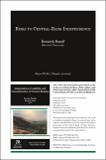Artículo
Risks to central-bank independence
Date
2021-10Abstract
Central banking today faces a number of existential challenges. On the political side, and particularly after the financial crisis, the public has come to expect central banks to take on a dizzying array of responsibilities, some far beyond their power or remit. These include everything from enhanced financial regulation to quasi-fiscal policy to mitigating economic inequality. Some recent populist proposals appear to be based on the presumption that central banks can issue large quantities of bank reserves indefinitely without any long-term inflationary or tax consequences. On the technocratic side, many central banks struggle with the trend decline in global real interest rates that steepened notably in the aftermath of the financial crisis. This decline has, in many cases, left the monetary authorities with little space to cut policy interest rates in the event of steep recession, much less in a financial crisis, and trying to put the best public face possible on much weaker “alternative monetary instruments,” such as quantitative easing (QE). At the same time, the fact that many “alternative monetary instruments” are in fact forms of fiscal policy—that could be implemented just as well or even better by finance ministries—has made the challenge of preserving centralbank independence against strong political headwinds even harder.
Collections
View/

The following license files are associated with this item:

